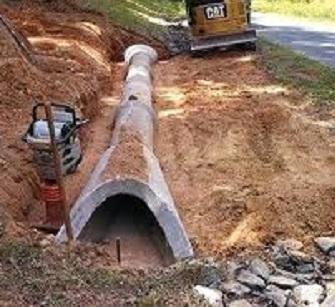Culvert Setup Made Easy: Step-by-Step Guide for Success
From selecting the suitable culvert dimension to integrating correct water drainage steps, each step in the installment process plays a critical role in the capability and longevity of the culvert system. Stay tuned to discover the crucial actions and considerations that can make culvert installation a seamless and effective undertaking.
Picking the Right Culvert Dimension
Selecting the ideal culvert size is important for making sure effective water flow and architectural honesty in culvert setup projects - Pad Construction. The size of the culvert straight impacts the flow capacity of water with the framework. A culvert that is also little can bring about flooding and overflow, while one that is also huge might result in reduced water rate, potentially creating sediment buildup and obstructions
To establish the right culvert dimension, variables such as the watershed area, optimal circulation rates, and hydraulic efficiency requirement to be carefully considered. Calculations based upon these specifications assist in selecting a size that can sufficiently manage the anticipated water quantity while lessening the risk of blockages and structural failing.
It is essential to consult design standards and standards to guarantee that the chosen culvert dimension meets the task requirements and regional policies (Pad Construction). By choosing the ideal culvert size, project managers can enhance water circulation, prevent potential concerns, and enhance the total efficiency and longevity of the culvert installation
Preparing the Installation Website
Reliable culvert setup necessitates precise preparation of the installation website to make sure ideal architectural support and performance. Prior to beginning the installation process, it is critical to clear the site of any kind of debris, vegetation, or obstructions that could hamper the culvert's placement.
Additionally, it is crucial to think about factors such as dirt make-up, groundwater levels, and environmental impacts when preparing the installation site. Performing a complete website assessment can help identify any kind of potential challenges or threats that might affect the culvert's efficiency. By putting in the time to prepare the installment site properly, you can help assure an effective culvert setup that satisfies structural demands and makes sure long-term capability.
Placing the Culvert Properly

The quality at which the culvert is positioned is crucial for keeping an appropriate slope for water flow. A steady incline aids avoid pooling and advertises efficient drainage. Additionally, go to my blog the culvert should be oriented properly to guarantee that the inlet and outlet remain in the appropriate areas. This positioning is necessary for the culvert to work properly in handling water flow.
Backfilling and Condensing the Dirt
Appropriate backfilling and compaction of the dirt around the culvert is vital to make sure stability and stop possible issues in the future. Once the culvert is appropriately positioned, the next essential action is to backfill the area around it with ideal product.
After putting the backfill material, it is essential to portable it in layers of uniform density. Making use of a compactor or a mechanical meddle, compact the dirt delicately to avoid damaging the culvert. Compaction helps in lowering the opportunities of settlement and ensures consistent support around the culvert. It is crucial to compact the soil evenly on all sides of the culvert to maintain its architectural integrity.
Appropriate backfilling and compaction not just provide stability to the culvert however also help in preventing soil disintegration and Continue maintaining the durability of the culvert system.
Making Certain Appropriate Drainage Assimilation
Incorporating reliable drain services plays a crucial duty in the total functionality and durability of culvert installments. Appropriate water drainage combination is necessary for handling water flow, preventing erosion, and ensuring the architectural honesty of the culvert system. To accomplish this, it is important to create a detailed drain strategy that takes into consideration aspects such as the quantity of water expected, the topography of the area, and the sort of dirt existing.

Additionally, incorporating features like disintegration control steps, such as riprap or plants, can even more boost the performance of the drain system. By carefully intending and implementing these drain remedies, culvert setups can function successfully and hold up against the test of time.
Conclusion
Finally, correct culvert installment is critical for keeping effective drain systems. By picking the best culvert size, preparing the installation site, positioning the culvert appropriately, backfilling and condensing the soil, and ensuring correct drainage combination, success can be attained. Following these steps will recommended you read certainly help make sure the longevity and effectiveness of the culvert, ultimately adding to the general success of the water drainage system.